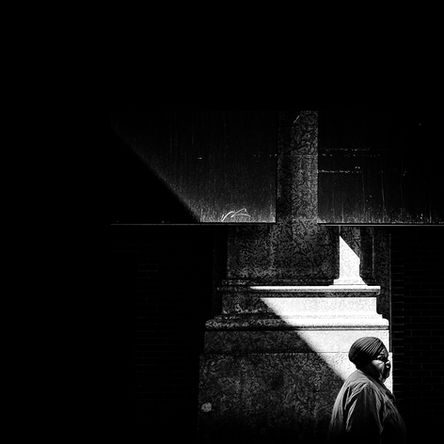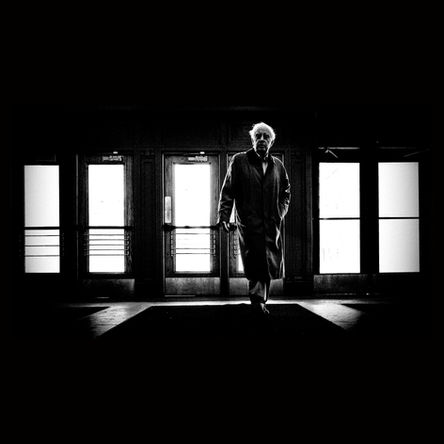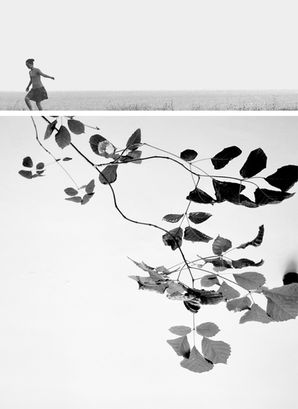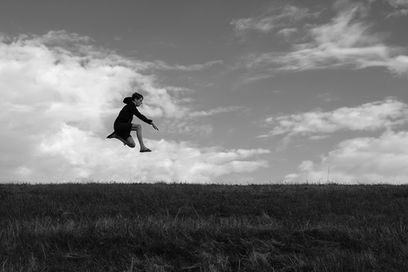
BURN AND DODGE
January 18, 2021
INTERVIEW
PHOTOGRAPHY David Lawless
INTERVIEW Melanie Meggs
David Lawless is a sous chef from Winnipeg, Canada, with a creative eye for capturing the beauty of life around him. When he’s not creating dishes, you can find him with his camera in hand, shooting stunning black and white street photography. Inspired by masters like Ray Metzger, Trent Parke and Fan Ho, David strives to capture the raw beauty of everyday life and to create stunning images with light as its primary focus. Through his striking photos, he hopes to bring attention to moments that would otherwise go unnoticed.

“Winnipeg isn't a big city and when you've lived in the same place your whole life things can become mundane. Been there, done that, took a photo. I think that's a situation a lot of photographers face. I guarantee if I showed a random photo of Winnipeg to someone who's lived here as long as I have they could tell me exactly where it was taken and the best route to get there. What I would like to express through my photography is a lesser-known Winnipeg. To take something commonplace and show it in a unique light. I try to include line, shape and form in all of my photos. Those are my favourite photographic elements. I do like texture as well but that doesn't always fit in with the more graphic style of photo I currently prefer.”
IN CONVERSATION WITH DAVID LAWLESS
THE PICTORIAL LIST: David please tell us about yourself. How did you become interested in photography?
DAVID LAWLESS: I was born and raised in Winnipeg, Manitoba Canada and I am still living here today. I have a job as the executive sous chef at a private club in the city, along with a wife and two cats.
My interest in photography came later in life and was sparked by my father who has been a hobbyist photographer for as long as I can remember. We took a trip to the UK in 2011 and I remember him bringing along his new DSLR. Watching him in the process of shooting, editing and then seeing the finished product excited me and I knew that photography was something I wanted to try. When I arrived home I purchased my first camera, a Canon Rebel for less than $300.
At the start of my photographic journey, my subjects were very different. I was drawn to nature and spent many hours chasing insects and hanging around flower beds. This went on for years and it wasn't until I started looking into online art communities that I discovered street photography, which took me in a very different direction.
TPL: Where do you find your inspiration to photograph?
DL: One of the places I find inspiration is photographers I follow on Instagram. There are quite a few photographers I admire on the social media site who are really fantastic. These are people who have the ability to show consistency and creativity through their work, which is something I'm working toward with my own photography.
TPL: Do you have a favourite place(s) to shoot in?
DL: No. Where I like to shoot changes often and usually corresponds to my last successful photo. If I feel I've captured something special in a certain place I may go back a few times and see if I can get another useful shot. But basically, if I have a camera in hand, I'm happy to shoot anywhere.
TPL: What happens when you walk the streets with your camera? Do people respond positively to you, or do you sometimes get negative reactions? If yes, how do you handle it?
DL: I've had a few negative reactions from people but nothing I wasn't able to defuse. I do my best to be confident and act in a way that shows I'm not doing anything wrong. I think when you give off nervous energy, people become suspicious and start to wonder what you might be up to. I smile and explain myself when necessary. Once someone knows I'm not out to cause any trouble they usually go about their business.
TPL: Do you have any favourite artists or photographers you would like to share with us, and the reason for their significance?
DL: I am probably most inspired by the work of photographers Ray Metzger, Trent Parke and Fan Ho. They are masters of using light and shadow as graphic elements in their compositions. This is something I practice and look for in my own images.
It happens once and then it's gone...leaving bugger all. This makes me think about the fleeting nature of street photography. It reminds me to stay focused in the moment or risk missing the shot.

TPL: Does the equipment you use help you in achieving your vision in your photography? What camera do you use? Do you have a preferred lens/focal length?
DL: I have a couple of different cameras but the one I use for my street photography is a Canon EOS M3 with a 22mm f/2 prime lens. The M3 is perfect for street photography because it's small and goes unnoticed. As far as the technology and image quality goes, it's pretty dated. I keep thinking about getting an upgrade but the graininess and low dynamic range of the M3 gives my photos a certain look that I would like to keep. So in this instance, I guess my dated old M3 does help me achieve a certain vision.
TPL: When you go out on the streets, do you have a concept in mind of what you want to shoot, or do you let the images just "come to you", or is it both?
DL: A little of both. My shooting process is for the most part reactive. I like to wander around looking for graphic elements, interesting light and shadow. If I find someplace that has potential I'll stop for a while and frame-up different compositions to see if there's a shot to be had. I tend to get ideas or concepts after I've visited a spot a couple of times and may go back to see if I can't capture the idea I see in my head
TPL: Have you ever been involved in the artistic world before photography?
DL: Not in the strict sense. I used to draw quite a bit as a child and have dabbled with painting and sculpting. I've even taken a couple of graphic design courses. But none of that speaks to me the way photography does.
TPL: What are some of your goals as an artist? Where do you see yourself or hope to see yourself in five years?
DL: My photography goals are simple, to stay consistent, have fun and shoot as much as possible. For me, photography is a hobby. I have a full-time job, so photography doesn't have to be more than it is, it can be pure enjoyment. I find that when I put too much pressure on myself with regards to photography it starts to feel a lot like work. The more pressure to attain certain goals the less I want to shoot. Which is something no photographer wants. So I'm not looking that far ahead, right now I just want to move forward, one step at a time and appreciate the process of making photos.
TPL: When I am not out photographing, I (like to)…
DL: I have been interested in Brazilian Jiu-Jitsu for about ten years. For those who might not be familiar with Brazilian jiu-jitsu, it's a martial art and combat sport that revolves around grappling, submission holds and the skill of taking an opponent to the ground. Once on the ground, the idea is to control your opponent, gain a dominant position and use several techniques to force a submission by way of a joint lock chokehold.

David Lawless is an incredibly talented photographer, who has a keen eye for capturing beauty in the everyday. With his photography, he hopes to draw attention to moments that often go unnoticed, and to create stunning images with light as its primary focus. To stay up to date with David's work, and be inspired by his vision, connect with him on Instagram!





































